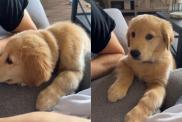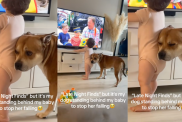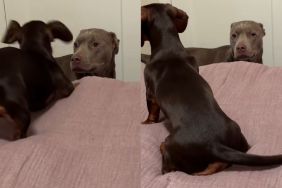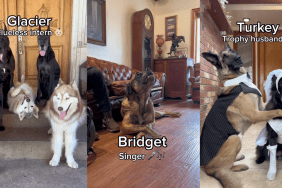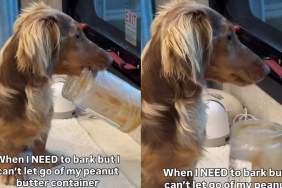Teaching your dog the ‘down’ command
With your puppydog sitting, say “Rover Down.” Let it sniff another food treat, and then quickly lower the lure to the ground between the pup’s forepaws. Most dogs assume a ‘playbow‘ posture – forequarters lowered with sternum on the ground and hindquarters stuck up in the air as if they are mooning the moon. By slowly moving the treat: either a few inches forwards away from the pup’s forepaws, or backwards between its forelegs towards the dog’s chest, the rump will lower to the ground, and your pup will lie down. When the puppy lies down, give it the treat as a reward.
If your puppy stands up instead, just start over from the beginning. At this stage of training, reprimands would be utterly inappropriate, since the puppy has no idea what we are trying to teach, and so as yet, it is not doing anything wrong. Neither is it doing it right. So, back to square one and start over.
Teaching your dog ‘down’ from a standing position
With your pup standing, say “Rover Down.” Lower a treat to the ground to a spot between the pup’s forepaws, and once your pup lowers its head, slowly move the lure backwards between its forelegs, and the rump will collapse. If the pup backs up, perform the exercise in a corner. This is the hardest of all the body-position changes, and so be patient and persevere. Remember, the first time is always the hardest. Once the pup has done it just a couple of times, it will be as easy as falling off a log.
Training games: Sit-down-stand sequences
Vary the order of the sit, down, and stand commands at random, or by using the following, easy-to-remember test sequences:
1. sit-down-sit-stand-down-stand
2. sit-stand-sit-down-stand-down
3. down-sit-down-stand-sit-stand
Varying at least three different body positions increases the speed with which the pup learns verbal commands. If we alternated just two body positions, e.g., sit and down – ‘doggy push-ups’, the pup would quickly become bored with endless repetition, and it would anticipate each command rather than listen to the owner’s instructions. For example, the pup quickly learns, if it is sitting, the next command must be “Down.” Varying the order of instructions increases your puppy’s attentiveness and concentration.
For the first sequence only, reward your pup following each change of body position. On the second sequence, reward after every other change, then after three changes and so on until the pup performs an entire sequence of six responses for just one reward. After only a few trials, a single food reward is more than sufficient for your pup to perform several complete sequences in succession. Do no more than five repetitions at any one time, and reserve food rewards for those special responses performed with particular pizzazz and panache.
Repeat the above sequences at least 50 times a day, until you and the pup are picture-perfect. Do NOT do all repetitions at once, or else you will bore your dog silly. Also, performing the exercises in a single training session produces a dog which is only reliable at training times, for example in the kitchen before dinner. To create a dog which is reliable at all times, you must train it at all times in a wide variety of settings. To accomplish this with minimal expenditure of effort and energy, integrate training into your daily routine. Call your dog and perform just one sequence: each time you turn on the stove, open the fridge, make a cup of tea or go to the bathroom, when the clock chimes, when you turn a page of a magazine, book or newspaper, when you turn on the television and during each commercial break and whenever you think of it. Similarly, when walking the dog, perform a single sequence: before putting on and taking off the dog’s leash, each time you go through a door or gate, each time you see another dog or person, each time you pass a lamppost or fire hydrant, before and after crossing the street and, whenever you think of it. You will find it easy to have several hundred mini-training sessions each day without deviating too much from your daily routine. Moreover, when your puppy collides with adolescence, you will find your daily routine runs smoother with a well-trained dog.
Excerpted from How to Teach a New Dog Old Tricks, by Ian Dunbar.
Ian Dunbar is a veterinarian and animal behaviorist, founder of the Association of Pet Dog Trainers, and the author and star of numerous books and videos on dog behavior and training. He lives in Berkeley, California with his wife, trainer Kelly Dunbar, and their three dogs. The Dunbars are contributing editors to DogTime.

